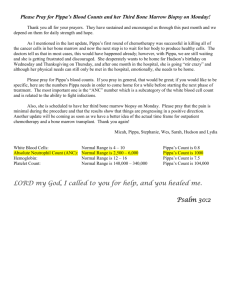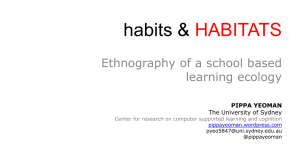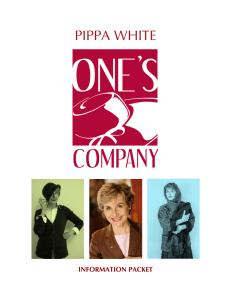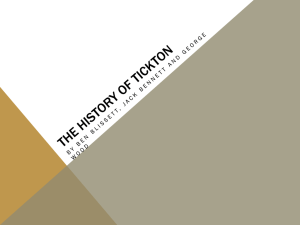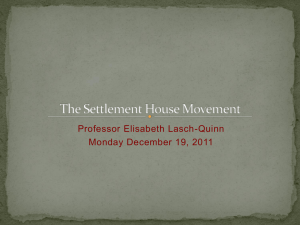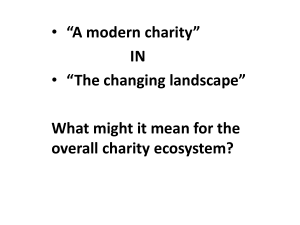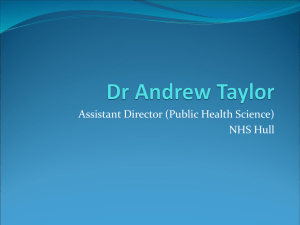Demonstrating impact – Pippa Robson
advertisement
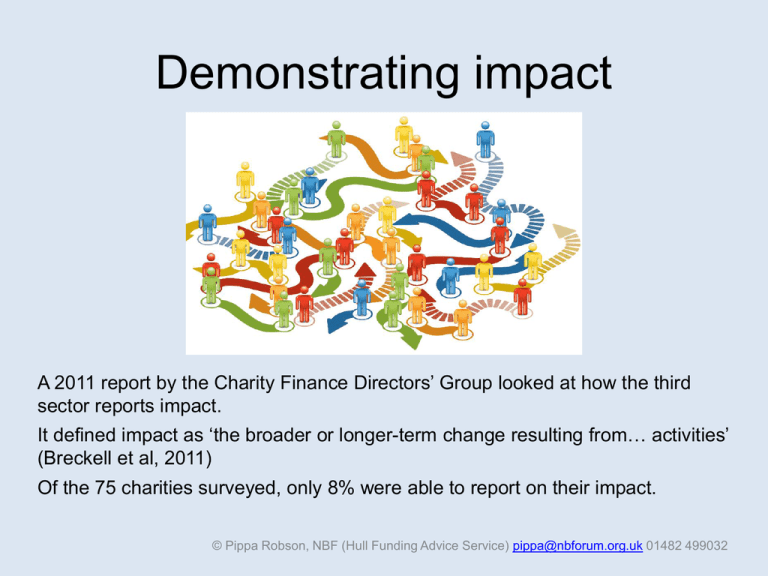
Demonstrating impact A 2011 report by the Charity Finance Directors’ Group looked at how the third sector reports impact. It defined impact as ‘the broader or longer-term change resulting from… activities’ (Breckell et al, 2011) Of the 75 charities surveyed, only 8% were able to report on their impact. © Pippa Robson, NBF (Hull Funding Advice Service) pippa@nbforum.org.uk 01482 499032 How about you…? A survey of the websites of 15 organisations that booked onto this workshop showed: 7% Annual reports 7% 27% 13% Website but no impact reporting Mention achievements Multiple Impact report 20% 27% Testimonials © Pippa Robson, NBF (Hull Funding Advice Service) pippa@nbforum.org.uk 01482 499032 So why bother? Volunteers Trustees Partners Beneficiaries Staff Funders Donors Customers © Pippa Robson, NBF (Hull Funding Advice Service) pippa@nbforum.org.uk 01482 499032 What can be collected • Outputs – numbers recorded on registers, databases, spreadsheets, booking forms. You can record attendees, hours spent supporting, volunteer hours, young people into work, training sessions delivered, food parcels distributed – the list is endless and this is why you must know what you want to demonstrate and for whom • Outcomes – self-reports, case studies, questionnaires, bespoke tools (Outcomes Star, SOUL Record etc.), observations, indirect evidence (for example a service user signing up as a volunteer indicates increased confidence), photos, videos, testimonials and thank you letters, follow-ups © Pippa Robson, NBF (Hull Funding Advice Service) pippa@nbforum.org.uk 01482 499032 Example projects http://www.nowproject.co.uk/sites/default/files/IMPACT_CARD_INFOGRAPHIC.pdf http://greenerleith.org.uk/our-impact http://simononthestreets.co.uk/about-homeless-support-charity/why-we-aredifferent/ http://www.prisonadvice.org.uk/Resources/Pact/Document/impactreport201213v4small.pdf © Pippa Robson, NBF (Hull Funding Advice Service) pippa@nbforum.org.uk 01482 499032 Measuring and evaluating Described as an international collective programme, with online impact resources that help charity sector organisations to know what to measure, and how. Features a self-assessment impact tool called Measuring Up. Supported by NPC, CES and NCVO CES is now part of NCVO. Long history in evaluation methods and consultancy. Evaluation is a key stage in demonstrating impact – CES offer guidance on costing evaluations New Philanthropy Capital use a Theory of Change approach to help charities work through what they are trying to achieve – if you are not clear about this then it will be much harder to measure your impact HACT is the Housing Associations’ Charitable Trust, but their in-depth work on calculating social value is applicable across the sector Putting a value on social impact There has been a drive over recent years to place a financial value on the work charities and social businesses do. Methods usually involve looking at two things: The downstream savings, or ‘savings to the public purse’ created by a project (if we didn’t help x people to stop misusing drugs, it would cost the government x in healthcare costs) Attaching a financial value to a less tangible outcome, like reduced isolation (what do people pay to feel socially included?) © Pippa Robson, NBF (Hull Funding Advice Service) pippa@nbforum.org.uk 01482 499032 Social Return on Investment Social Return on Investment is a method of measuring value that is not traditionally reflected in an organisation’s financial accounts. The SROI Network was formed in 2006 and has standardised the processes undertaken to calculate this value. Undertaking a full SROI analysis is timeconsuming, expensive and complex. It looks at: • Stakeholders – full mapping • Outcomes – detailed examination of the difference you make • Valuations – attaching a financial value to the differences you identify • Attribution – how different interventions have contributed to outcome • Deadweight - how many people would have ‘got better anyway’ etc. • Drop-off – how the impact you make diminishes over time © Pippa Robson, NBF (Hull Funding Advice Service) pippa@nbforum.org.uk 01482 499032 Challenges and issues • It can be hard to show the impact of very short-term projects, one-day events or ‘audience’ projects like theatre sessions • Gathering evidence about your impact may highlight that you have not made the difference you originally thought – can be positive or negative • Knowing how far to go in claiming outcomes – if NBF helps a group to get funding, are all the outcomes stemming from that funded project part of our impact? • Longer-term impact can only be measured if you are still in contact with a proportion of your beneficiaries – although you can use data to your advantage (e.g. studies show…) © Pippa Robson, NBF (Hull Funding Advice Service) pippa@nbforum.org.uk 01482 499032 Useful links and resources The Global Value Exchange http://www.globalvaluexchange.org/valuations/ Charities Evaluation Service http://www.ces-vol.org.uk/ NCVO blog with list of good examples http://blogs.ncvo.org.uk/2013/11/12/small-charitiesbig-impact/ New Philanthropy Capital http://www.thinknpc.org/our-work/our-services/measuringimpact-2/ Report: Impact Reporting in the UK Charity Sector (Breckell et al, 2011) http://www.cfg.org.uk/resources/~/media/Files/Resources/Impact%20Reporting%20in%20 the%20UK%20Charity%20Sector.ashx Know How Non Profit http://knowhownonprofit.org/organisation/quality/mande/evaluatingoutcomes-and-impact Inspiring Impact http://inspiringimpact.org/ Social Return on Investment Network http://www.thesroinetwork.org/ HACT http://www.hact.org.uk/measuring-social-impact-community-investment-guideusing-wellbeing-valuation-approach http://www.hact.org.uk/value-calculator
